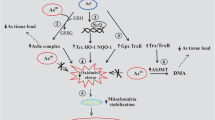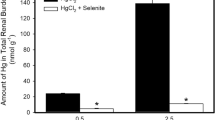Abstract
Arsenite has been known for half a century to have a protective effect against selenium poisoning. Paradoxically, arsenite inhibits the conversion of inorganic selenium salts to methylated excretory products, although methylation has long been regarded as a detoxification mechanism for selenium. Moreover, there is evidence for a pronounced synergistic toxicity between arsenite and methylated selenium metabolites. We investigated the effect of arsenite on the acute toxicity of a variety of methylated or nonmethylated selenium compounds, as well as methylated forms of sulfur and tellurium. Adult male rats were injected with sodium arsenite (4 mg As/kg bw, s.c.) 10 min prior to injection of the test compounds; at the doses employed, none of the test compounds caused mortality, nor did arsenite, when given alone. When given with arsenite, the following methylated compounds produced toxic signs and high morality at the indicated dosages (mg Se/kg): Methylseleninic acid (2), dimethylselenoxide (2), trimethylselenonium chloride (3), selenobetaine (2), selenobetaine methylester (2, also 1 and 0.5), and Se-methylselenocysteine (2). Toxic signs but no mortality occurred when arsenite was given with selenomethionine (2 mg Se/kg). No enhancement of toxic signs or mortality occurred when arsenite was given with sulfobetaine (0.8 mg S/kg), dimethylsulfide (320 mg S/kg), or the following (nonmethylated) forms of selenium: sodium selenite (2), selenocystine (2), and phenylselenol (2). Arsenite also increased the toxicity of trimethyltelluronium chloride (4.8 mg Te/kg). Like arsenite, periodate-oxidized adenosine (100 μmoles/kg), which is known to inhibit the formation of dimethylselenide and trimethylselenonium ion in vivo, caused increased 24 h mortality when given with various methylated selenium compounds. The results show that arsenite markedly enhances the toxicity of methylated selenium compounds, in contrast to the effect of arsenite on inorganic selenium salts. Arsenite appears to have a number of different, sometimes opposing, effects on selenium metabolism. It may enhance the toxicity of partially-methylated forms by blocking some process in their detoxification, such as methylation.
Similar content being viewed by others
References
Levander, O. A. (1977),Environ. Health Perspect. 19, 159.
Moxon, A. L. (1938),Science 88, 81.
Moxon, A. L. and Rhian, M. A. (1943),Physiol. Rev.,23, 305.
Palmer I. S. and Bonhorst, C. W. (1957),Agric. Food Chem. 5, 928.
Obermeyer, B. D., Palmer, I. S., Olson, O. E., and Halverson, A. W. (1971),Toxicol. and Appl. Pharmacol. 20, 135.
Foster, S. J., Kraus, R. J., and Ganther, H. E. (1986),Arch. Biochem. Biophys. 247, 12.
Ganther, H. E. and Baumann, C. A. (1962),J. Nutr. 77, 210.
Hsieh, H. S. and Ganther, H. E. (1977),Biochem. Biophys, Acta. 497, 205.
Tandon, S. K., Magos, L., and Webb, M. (1986),Biochem. Pharmacol. 35, 2763.
Hoffman, J. L. and McConnell K. P. (1987),Arch. Biochem. Biophys. 254, 534.
Hsieh, H. S. and Ganther, H. E. (1975),Biochemistry 14, 1632.
Esaki, N., Nakamura, T., Tanaka, H., and Soda, K. (1982),J. Biol. Chem. 257, 4386.
Palmer, I. S. and Halverson, A. W. (1974),Fed. Proc. 33, 694 (abstract).
Parizek, J., Ostadalova I., Kalouskova, J., Babicky, A., and Benes, J. (1971),Newer Trace Elements in Nutrition, eds., Mertz, W. and Cornatzer, W. E., Dekker, New York, 85.
Hoffman, J. L. (1979),Transmethylation, eds., Usdin, E., Borchardt, R. T., and Creveling, C. R., Elsevier, New York, 181.
Mozier, N. M., McConnell, K. P., and Hoffman, J. L. (1988),J. Biol. Chem. 263, 4527.
Marshall, E. (1985),Science 229, 144.
Ip, C. and Ganther, H. E. (1988),Carcinogenesis 9, 1481.
Schrauzer, G. N., White, D. A., McGinness, J., and Schneider, C. J. (1978),Bioinorg. Chem. 9, 245.
Author information
Authors and Affiliations
Rights and permissions
About this article
Cite this article
Kraus, R.J., Ganther, H.E. Synergistic toxicity between arsenic and methylated selenium compounds. Biol Trace Elem Res 20, 105–113 (1989). https://doi.org/10.1007/BF02919103
Received:
Accepted:
Issue Date:
DOI: https://doi.org/10.1007/BF02919103




